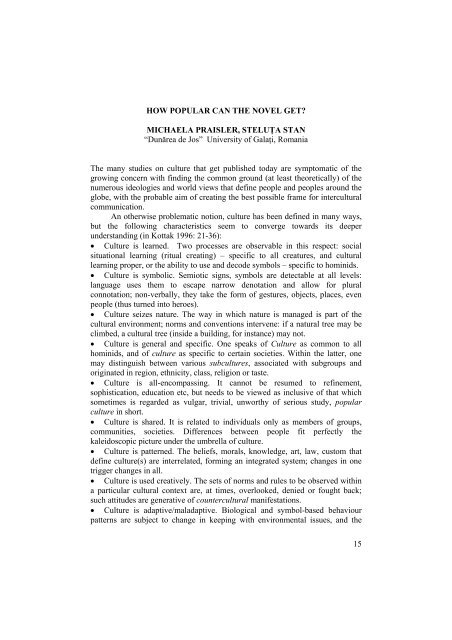culture, subculture and counterculture - Facultatea de Litere
culture, subculture and counterculture - Facultatea de Litere
culture, subculture and counterculture - Facultatea de Litere
You also want an ePaper? Increase the reach of your titles
YUMPU automatically turns print PDFs into web optimized ePapers that Google loves.
HOW POPULAR CAN THE NOVEL GET?<br />
MICHAELA PRAISLER, STELUŢA STAN<br />
“Dunărea <strong>de</strong> Jos” University of Galaţi, Romania<br />
The many studies on <strong>culture</strong> that get published today are symptomatic of the<br />
growing concern with finding the common ground (at least theoretically) of the<br />
numerous i<strong>de</strong>ologies <strong>and</strong> world views that <strong>de</strong>fine people <strong>and</strong> peoples around the<br />
globe, with the probable aim of creating the best possible frame for intercultural<br />
communication.<br />
An otherwise problematic notion, <strong>culture</strong> has been <strong>de</strong>fined in many ways,<br />
but the following characteristics seem to converge towards its <strong>de</strong>eper<br />
un<strong>de</strong>rst<strong>and</strong>ing (in Kottak 1996: 21-36):<br />
• Culture is learned. Two processes are observable in this respect: social<br />
situational learning (ritual creating) – specific to all creatures, <strong>and</strong> cultural<br />
learning proper, or the ability to use <strong>and</strong> <strong>de</strong>co<strong>de</strong> symbols – specific to hominids.<br />
• Culture is symbolic. Semiotic signs, symbols are <strong>de</strong>tectable at all levels:<br />
language uses them to escape narrow <strong>de</strong>notation <strong>and</strong> allow for plural<br />
connotation; non-verbally, they take the form of gestures, objects, places, even<br />
people (thus turned into heroes).<br />
• Culture seizes nature. The way in which nature is managed is part of the<br />
cultural environment; norms <strong>and</strong> conventions intervene: if a natural tree may be<br />
climbed, a cultural tree (insi<strong>de</strong> a building, for instance) may not.<br />
• Culture is general <strong>and</strong> specific. One speaks of Culture as common to all<br />
hominids, <strong>and</strong> of <strong>culture</strong> as specific to certain societies. Within the latter, one<br />
may distinguish between various sub<strong>culture</strong>s, associated with subgroups <strong>and</strong><br />
originated in region, ethnicity, class, religion or taste.<br />
• Culture is all-encompassing. It cannot be resumed to refinement,<br />
sophistication, education etc, but needs to be viewed as inclusive of that which<br />
sometimes is regar<strong>de</strong>d as vulgar, trivial, unworthy of serious study, popular<br />
<strong>culture</strong> in short.<br />
• Culture is shared. It is related to individuals only as members of groups,<br />
communities, societies. Differences between people fit perfectly the<br />
kaleidoscopic picture un<strong>de</strong>r the umbrella of <strong>culture</strong>.<br />
• Culture is patterned. The beliefs, morals, knowledge, art, law, custom that<br />
<strong>de</strong>fine <strong>culture</strong>(s) are interrelated, forming an integrated system; changes in one<br />
trigger changes in all.<br />
• Culture is used creatively. The sets of norms <strong>and</strong> rules to be observed within<br />
a particular cultural context are, at times, overlooked, <strong>de</strong>nied or fought back;<br />
such attitu<strong>de</strong>s are generative of countercultural manifestations.<br />
• Culture is adaptive/maladaptive. Biological <strong>and</strong> symbol-based behaviour<br />
patterns are subject to change in keeping with environmental issues, <strong>and</strong> the<br />
15












